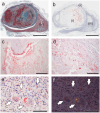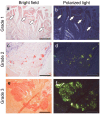Exploring the Histopathological Features of Thrombus-Associated Localized Amyloid Deposition: Comprehensive Analysis Employing Immunohistochemistry and Proteomics
- PMID: 40429650
- PMCID: PMC12111168
- DOI: 10.3390/ijms26104505
Exploring the Histopathological Features of Thrombus-Associated Localized Amyloid Deposition: Comprehensive Analysis Employing Immunohistochemistry and Proteomics
Abstract
Amyloid deposition has been reported to localize within thrombi; however, its pathological characteristics, particularly its precursor proteins, remain poorly understood. This study aimed to elucidate the pathological features of thrombus-associated amyloid deposition by immunohistochemistry combined with proteomic analyses using liquid chromatography-tandem mass spectrometry with laser microdissection. Our findings revealed that thrombus-associated amyloid deposits within the thrombus and vessel wall primarily comprised apolipoprotein A-I, with a mixture of amyloid fibrils derived from amyloidogenic proteins, including transthyretin and lactoferrin. Given that these proteins are present in the blood, our results support a previous hypothesis that proteins denatured during thrombus aging are a source of amyloid. Furthermore, phagocytes were infiltrated around the intramural and extravascular deposits rather than around the amyloid deposits within the thrombus. Therefore, amyloid deposits generated within the thrombus may be transported from regions with limited blood flow to the vessel wall and surrounding tissues, where blood flow is present, during thrombus processing. These deposits were primarily removed by phagocytic cells. Our results suggest that a facilitative effect on deposition occurs via a cross-seeding mechanism between amyloid fibrils and that phagocytes can remove amyloid deposits. These findings help elucidate the pathogenesis of localized amyloidosis.
Keywords: apolipoprotein A-I; atherosclerosis; lactoferrin; localized amyloidosis; phagocyte; proteomics; thrombus; transthyretin.
Conflict of interest statement
The authors declare no conflicts of interest.
Figures








Similar articles
-
Wild-type transthyretin significantly contributes to the formation of amyloid fibrils in familial amyloid polyneuropathy patients with amyloidogenic transthyretin Val30Met.Hum Pathol. 2011 Feb;42(2):236-43. doi: 10.1016/j.humpath.2010.06.014. Epub 2010 Nov 5. Hum Pathol. 2011. PMID: 21056899
-
A case of spheroid-type localized lactoferrin amyloidosis in the bronchus.Pathol Int. 2019 Apr;69(4):235-240. doi: 10.1111/pin.12774. Epub 2019 Feb 19. Pathol Int. 2019. PMID: 30779453
-
Knee osteoarthritis associated with different kinds of amyloid deposits and the impact of aging on type of amyloid.Amyloid. 2016;23(1):26-32. doi: 10.3109/13506129.2015.1115758. Epub 2015 Dec 24. Amyloid. 2016. PMID: 26701417
-
Confirming the Diagnosis of Amyloidosis.Acta Haematol. 2020;143(4):312-321. doi: 10.1159/000508022. Epub 2020 Jun 16. Acta Haematol. 2020. PMID: 32544917 Review.
-
Amyloid-Forming Corpora Amylacea and Spheroid-Type Amyloid Deposition: Comprehensive Analysis Using Immunohistochemistry, Proteomics, and a Literature Review.Int J Mol Sci. 2024 Apr 4;25(7):4040. doi: 10.3390/ijms25074040. Int J Mol Sci. 2024. PMID: 38612850 Free PMC article. Review.
References
-
- Buxbaum J.N., Eisenberg D.S., Fandrich M., McPhail E.D., Merlini G., Saraiva M.J.M., Sekijima Y., Westermark P. Amyloid nomenclature 2024: Update, novel proteins, and recommendations by the International Society of Amyloidosis (ISA) Nomenclature Committee. Amyloid. 2024;31:249–256. doi: 10.1080/13506129.2024.2405948. - DOI - PubMed
-
- Ichimata S., Hata Y., Yoshinaga T., Katoh N., Kametani F., Yazaki M., Sekijima Y., Nishida N. Amyloid-forming corpora amylacea and spheroid-type amyloid deposition: Comprehensive analysis using immunohistochemistry, proteomics, and a literature review. Int. J. Mol. Sci. 2024;25:4040. doi: 10.3390/ijms25074040. - DOI - PMC - PubMed
MeSH terms
Substances
Grants and funding
LinkOut - more resources
Full Text Sources
Medical
Research Materials

